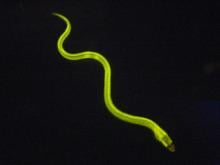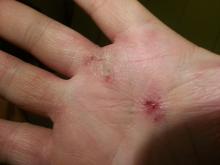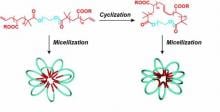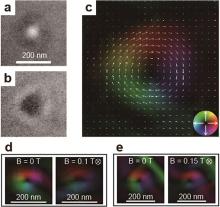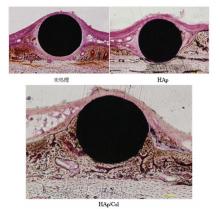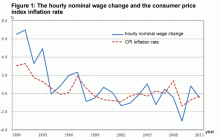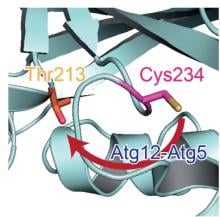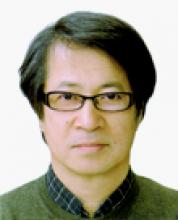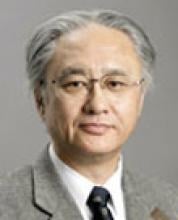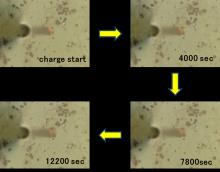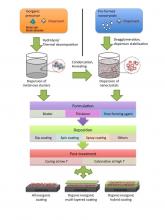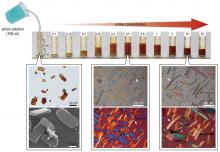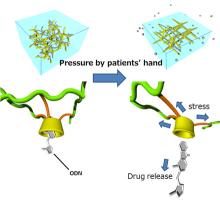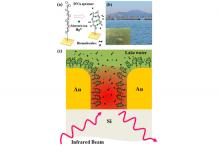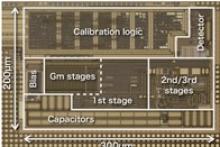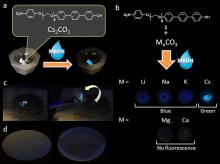Japan
News
19 Jun 2013
(Okayama, Japan, 19 June) - Highlights include IT-based insights into the mysteries of Japan's ancient 'Kofun' burial mounds; pioneering research on the Standard Model Higgs boson; synthesis of silafluorenes; vesicular neurotransmitter transporters and clean biochemistry; and IP on the synthesis of graphene oxide and nanocomposite applications.
13 Jun 2013
Unagi, the sea-going Japanese freshwater eel, harbors a fluorescent protein that could be the basis for a revolutionary new clinical test for bilirubin, a critical indicator of human liver function, hemolysis, and jaundice, according the RIKEN Brain Science Institute. The discovery could also contribute to the conservation of the endangered Unagi
06 Jun 2013
Atopic dermatitis or eczema was big business in Japan in the 1990's. Assistant Prof. Ushiyama interviewed patients in Japan and the UK. The article reviews the eczema business in Japan and the differences with the UK.
27 May 2013
(Tokyo, 27 May 2013): Scientists at Tokyo Tech have developed a new self-assembled nanostructure that can survive very hot or saline environments.
27 May 2013
(Tokyo, 27 May 2013) Self assembled nanostructures for hostile environments: the May 2013 issue the Tokyo Institute of Technology Bulletin contains the latest information about cutting edge research projects and related activities at Tokyo Tech.
24 May 2013
Researchers using Lorentz electron microscopy have shown that magnetic skyrmions are spontaneously formed as nanomagnetic clusters in a ferromagnetic manganese oxide with centrosymmetry.
24 May 2013
Researchers at the International Center for Materials Nanoarchitectonics (MANA) and Tokyo Medical and Dental University have developed a coating method which accelerates bonding with bone by 3 times.
24 May 2013
Researchers in Japan and US have developed a new technique for efficiently creating functionalized nanowires for the first time ever.

24 May 2013
Seventy. This is the number of journalists who were killed during 2012 in connection with news-gathering activities. The 34th entry from the top bears the name of a Japanese woman, Mika Yamamoto.
20 May 2013
Opinion article by Associate Professor Sachiko Kuroda of the Faculty of Education and Integrated Arts and Sciences, Waseda University
20 May 2013
The National Institute for Materials Science in cooperation with the Japan Aerospace Exploration Agency are evaluating the mechanical properties of metallic materials used in liquid rocket engines for Japan's H-IIA and H-IIB launch vehicles.
16 May 2013
(Tokyo, 16 May, 2013) Researchers at Tokyo Institute of Technology report details on the biological mechanisms through which cells degrade own cellular material, allowing them to survive starvation conditions.

13 May 2013
Kazuaki Sawada from Toyohashi Tech was awarded the FY2013 Science and Technology Award [Research Division] by the Minister of Education, Culture, Sports, Science and Technology.
13 May 2013
IOP Publishing (IOP) announced a new three year agreement with the National Institute for Materials Science (NIMS) for the continued publication of the open access title Science and Technology of Advanced Materials (STAM).
08 May 2013
Everyone’s been talking about the musical film Les Misérables that came out last year, but what is it that makes it so appealing? Opinion article by Prof. Yoshitaka Watanabe of Waseda University
08 May 2013
Opinion article by Prof. Waichiro Iwashi of Waseda University on the implementation of a new non-invasive prenatal genetic testing that uses maternal blood in Japan
30 Apr 2013
A research group at the International Center for Materials Nanoarchitectonics (MANA) of NIMS discovered an intriguing phenomenon in which an inorganic layered crystal expanded and contracted by 100 times its original size in a few seconds in an aqueous solution, displaying a behavior similar to a living cell.
26 Apr 2013
The NIMS Global Research Center for Environment and Energy based on Nanomaterials Science (GREEN) and Tokyo Metropolitan University have measured the volumetric expansion of single particles of silicon accompanying the charging reaction. This finding demonstrated the importance of electrode design from the viewpoint of volumetric energy density.
26 Apr 2013
Tsukuba, Japan 26 April - Nanoparticles are used in many commercial products catalysts to cosmetics. A review published today in the Science and Technology of Advanced Materials by researchers in Sweden and Spain describes recent work on the 3 main nanoparticles used in photocatalytic, UV-blocking and sunscreens.

17 Apr 2013
Two years after the Great East Japan Earthquake, Prof. Kohara outlines some problems faced by the local authorities in the areas afflicted by the disaster especially in rebuilding local administration and communities.
12 Apr 2013
Tsukuba, Japan & Los Angeles, Ca. 12 April - A new study by researchers at UCLA suggests that the elasticity of the physical matrix used for growing heart muscle cells outside of the body may be critical to the success of cardiac tissue engineering. The results were published in the journal Science and Technology of Advanced Materials this week.

09 Apr 2013
Opinion article by Prof. Yukiko Fukagawa of Waseda University "The freshest aspect of this administration is not the president’s position as the first female president of South Korea, but the president’s goal of achieving happy society and for being the first administration in history to push social policy."
29 Mar 2013
(Tsukuba, 29 March 2013) The first observation of massive swelling and shrinkage of inorganic layered materials like a biological cell provides insights into the production of two-dimensional crystals.
15 Mar 2013
A research group at NIMS International Center for Materials Nanoarchitectonics (MANA) have succeeded in developing a gel material which is capable of releasing drugs in response to pressure applied by the patient.
06 Mar 2013
Tsukuba, Japan 6 March - A research group at WPI-MANA have discovered that it is possible to detect diluted ionic mercury in water with more than 10 times higher sensitivity than with the conventional spectroscopy method.
05 Mar 2013
(Toyohashi, Japan, 5 March) Toyohashi Tech researchers have developed small-area, low-power, low-noise instrumentation amplifiers for high-spatial-resolution biomedical and environment monitoring system.

05 Mar 2013
(Toyohashi, Japan, 5 March) - From improving Japanese to English machine translation to carbon nanocoils fracture like an automobile spring—the Toyohashi Tech e-Newsletter offers reviews of its latest news
05 Mar 2013
(Tsukuba, 5 March 2013) 'Micrometre-level naked-eye detection' of caesium ions, a major source of contamination in the vicinity of radioactive leaks, is demonstrated in a material developed by researchers in Japan.

25 Feb 2013
Kanazawa, Japan, 25 Feb - From uncovering maternal to paternal communications in mice; obesity-induced diabetes linked to enzyme deficiencies; ‘cool’ organic solar cell fabrication; links of asthma to gender and more in covered in the Kanazawa University Research Bulletin
Researchers
Sorry, no researchers coming up for this topic.
Giants in history
Ruby Sakae Hirose (1904 – 1960) was a Japanese-American scientist whose research contributed significantly to our understanding of blood clotting, allergies and cancer.
Haisako Koyama (1916 – 1997) was a Japanese solar observer whose dedication to recording sunspots – cooler parts of the sun’s surface that appear dark – produced a sunspot record of historic importance.
Michiaki Takahashi (17 February 1928 – 16 December 2013) was a Japanese virologist who developed the first chickenpox vaccine.
Toshiko Yuasa (11 December 1909 – 1 February 1980) was the first Japanese female physicist whose research on radioactivity shed light on beta decay – the process in which an atom emits a beta particle (electron) and turns into a different element.
Baron Kitasato Shibasaburo (29 January 1856 – 13 June 1931) was a Japanese physician and bacteriologist whose work led to a new understanding of preventing and treating tetanus, diphtheria and anthrax.
By isolating soil microorganisms and studying the compounds they produce, Satoshi Omura (born 1935) discovered almost 500 organic compounds with unique properties that were produced by these microorganisms, including many new antibiotics.
In 1915, pathologist Katsusaburo Yamagiwa and his research assistant Koichi Ichikawa became the first to prove that chronic exposure to chemicals can cause cancer.
In 1915, Koichi Ichikawa along with pathologist Katsusaburo Yamagiwa became the first to prove that chronic exposure to chemicals can cause cancer.
Reiji Okazaki (8 October 1930 – 1 August 1975) and Tsuneko (7 June 1933) were a Japanese couple who discovered Okazaki fragments – short sequences of DNA that are synthesized during DNA replication and linked together to form a continuous strand.
Tsuneko (7 June 1933) and Reiji Okazaki (8 October 1930 – 1 August 1975) were a Japanese couple who discovered Okazaki fragments – short sequences of DNA that are synthesized during DNA replication and linked together to form a continuous strand.
Husband and wife team, Kimishige (3 December 1925 – 6 July 2018) and Teruko Ishizaka (28 September 1926 – 4 June 2019) discovered the antibody class Immunoglobulin E (IgE) that triggers allergic reactions. They also discovered that IgE antibodies attach to white blood cells, known as mast cells, releasing histamine, which causes allergic reactions.
Husband and wife team, Kimishige (3 December 1925 – 6 July 2018) and Teruko Ishizaka (28 September 1926 – 4 June 2019) discovered the antibody class Immunoglobulin E (IgE) that triggers allergic reactions. They also discovered that IgE antibodies attach to white blood cells, known as mast cells, releasing histamine, which causes allergic reactions.
Japanese chemist Takamine Jokichi (3 November 1854 – 22 July 1922) founded the Tokyo Artificial Fertilizer Company, where he isolated a starch-digesting enzyme (named takadiastase) from the fungus Aspergillus oryzae.
Hideki Yukawa (23 January 1907 – 8 September 1981) was awarded the Nobel Prize in Physics in 1949 for predicting the existence of the pi meson subatomic particle. Japan’s first Nobel laureate, Yakawa also expressed his support for nuclear disarmament by signing the Russell–Einstein Manifesto in 1955.
Shinichiro Tomonaga (31 March 1906 – 8 July 1979), together with Richard Feynman and Julian Schwinger, was awarded the Nobel Prize in Physics in 1965, for their contributions to advance the field of quantum electrodynamics. Tomonaga was also a strong proponent of peace, who actively campaigned against the proliferation of nuclear weapons and promoted the peaceful use of nuclear energy.
Japanese chemist Kenichi Fukui (4 October 1918 – 9 January 1998) was the first Asian scientist to be awarded the Nobel Prize in Chemistry. Together with Roald Hoffman, he received this honour in 1981 for his independent research into the mechanisms of chemical reactions.
Minoru Shirota (April 23, 1899 – March 10, 1982) was a Japanese microbiologist who invented the popular fermented drink Yakult.
Japanese physicist Ukichiro Nakaya (1900-1962) made the world’s first artificial snowflakes. He started his research on snow crystals in the early 1930s at Hokkaido University, where there is an unlimited supply of natural snow in winter. By taking over 3,000 photographs, he established a classification of natural snow crystals and described their relationship with weather conditions.
The techniques that make industrial pearl culturing possible were developed over a century ago at the Misaki Marine Biological Station in Japan. The station’s first director, Professor Kakichi Mitsukuri, emphasized to Kokichi Mikimoto in 1890 that stimulating pearl sac formation was important for pearl growth, and they went on to successfully develop methods for culturing pearls.
The field of solid-state ionics originated in Europe, but Takehiko Takahashi of Nagoya University in Japan was the first to coin the term ‘solid ionics’ in 1967. ‘Solid-state ionics’ first appeared in 1971 in another of his papers, and was likely a play on ‘solid-state electronics’, another rapidly growing field at the time.
Chika Kuroda (24 March 1884 – 8 November 1968) was a Japanese chemist whose research focussed on the structures of natural pigments.
Motoo Kimura (13 November 1924 – 13 November 1994) was a Japanese theoretical population geneticist who is best remembered for developing the neutral theory of molecular evolution.
Osamu Shimomura (27 August 1928 – 19 October 2018) was a Japanese organic chemist and marine biologist who dedicated his career to understanding how organisms emitted light.
Kikunae Ikeda (8 October 1864 – 3 May 1936) was a Japanese chemist who discovered the fifth basic taste, umami.
Umetaro Suzuki (7 April 1874 – 20 September 1943) was a Japanese scientist best remembered for his research on beriberi, a disease caused by vitamin B1 deficiency, characterized by limb stiffness, paralysis and pain.
Kono Yasui (16 February 1880 – 24 March 1971) was a Japanese botanist who researched the genetics of poppies, corn and spiderworts and surveyed the plants that had been affected by the nuclear fallout after the atomic bombings of Hiroshima and Nagasaki.
Hitoshi Kihara (1893 – 1986) was one of the most famous Japanese geneticists of the 20th century. One of his most significant contributions was identifying sex chromosomes (X and Y) in flowering plants.
Michiyo Tsujimura (17 September 1888 – 1 June 1969) was a Japanese agricultural scientist and biochemist recognized for her research of green tea components.
A Japanese surgeon, Tetsuzo Akutsu (20 August 1922 – 9 August 2007) built the first artificial heart capable of keeping an animal alive.
Ogino Ginko (3 March 1851 – 23 June 1913) was the first registered female doctor to practise modern medicine in Japan.
Japanese geochemist Katsuko Saruhashi developed the first method and tools for measuring carbon dioxide in seawater



